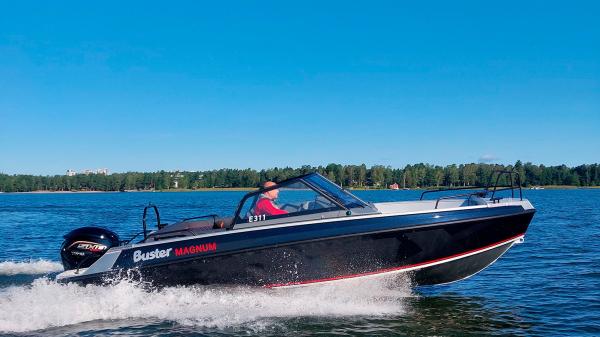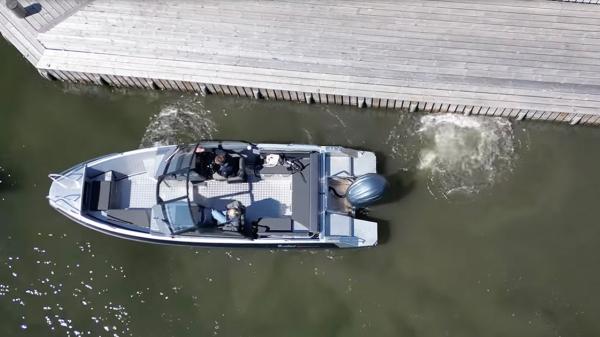12.10.2016
Autumn maintenance of Buster boats
The Scandinavian boating season is headed towards its end, and the time is approaching to winterise the boat. By performing the autumn maintenance appropriately, you can ensure successful winter storage for your boat, avoid unpleasant surprises caused by the winter and have the boat ready for a new season in the spring. For detailed instructions on how to maintain and care for your boat and its engine, we encourage you to consult the respective owner’s manuals. However, for your convenience, we have put together general instructions for the autumn maintenance of your Buster boat and made them available here. These tips were provided by Marko Karilainen at Karilainen Oy, an authorised Buster dealer in Ähtäri, Finland.
Hull and bottom
Inspect the boat’s hull. If the boat has been antifouled, also check the condition of the antifoul paint. In case there are any deficiencies in the antifoul paint, prepare to antifoul the boat again in the spring. We do not recommend antifouling the boat in the autumn, because the paint may dry excessively over the winter.
If the boat has an echo sounder, check that the transducer is intact.
Almost every boat features zinc anodes, or ‘sacrificial’ anodes. The purpose of these anodes is to protect the most important parts of the boat – the sterndrive, hull, prop and metallic through-hull fittings – from corrosion by ‘sacrificing' themselves to be eaten away.
If your boat has zinc anodes, check their condition and replace them as necessary.
Washing and cleaning
Wash the boat with detergents intended for this purpose. Buster’s product selection features the right detergents for cleaning aluminium hulls, GRP surfaces, windshields, cushions and canopies.
When cleaning the aluminium hull in the autumn, after you have washed the hull, finish the job by treating the hull with purpose-specific oil. Use of oil this way facilitates the boat's spring maintenance. Spread a thick layer of oil on aluminium surfaces and only wipe it off in the spring.
Allow the cushions and the canopy to dry out properly after cleaning, and if possible, stow them in a dry place for the winter. If you leave the canopy on for the winter, note that the canopy is not designed to withstand snow loads. Also ensure sufficient ventilation in the storage facility to avoid mildew formation on the canopy during the winter.
Check the through-hull fittings, fixing bolts, the mounting for echo sounder transducer and seals/sealants to ensure that they are in good working condition. If the seals/sealants appear brittle or hardened, they should be replaced.
Stopper and drain holes
Remove the threaded stopper so that bilge water can flow out. Check that the stopper is intact and get a new one if necessary. It may be a good idea to put the stopper in a small bag and tie the bag to the steering wheel, for example, so as to remind you of plugging it back in when spring comes.
Clean the drain holes and their pipes by rinsing with freshwater, for example, to remove any leaves and debris. Leave the bow of the boat elevated slightly higher than the stern to ensure that all water flows out and to allow the bilge and the floor to dry.
Check that the drain hole flaps are in good condition (that they are intact and have no cracks on them) so that the draining system works flawlessly.
Lights, locks and fire extinguisher
Check that the boat’s masthead lights and navigation lights are working and repair them or have them repaired where necessary. Make sure that the locks in the boat are working properly, so that you can both open them and lock them up effortlessly. See to it that the fire extinguisher is inspected according to official requirements applicable in your country or replace it with a new one. This should be done in the spring before the beginning of the new season, if not before.
Steering
Inspect the boat's steering system on a regular basis: ensure that the steering cable appears intact, and lubricate the steering cable as necessary. If the steering feels especially stiff, this may point to a cable defect. In this case, contact a professional service shop immediately.
Engine and filters
Always have the outboard engine serviced by an authorised service shop in accordance with the service schedule to ensure appropriate professional-level servicing for it. This way you also make sure that the warranty remains valid. Consult the owner’s manual of your outboard engine for those service measures you can – and should – carry out yourself.
Contemporary engines are particularly sensitive to changes in fuel quality. Check the fuel filter on the engine frequently enough and replace it as necessary.
In the autumn, add fuel stabiliser into the fuel tank of your outboard engine and run the engine for some time to circulate the additive into the engine and also to preserve the fuel already in the engine. Fuel stabiliser maintains fuel quality and helps to keep fuel fresh, but it cannot restore the properties of fuel that has already gone stale. You can also use alkylate petrol, or small engine fuel, in your outboard. This type of fuel does not form solids that would clog up the fuel system over time, and it is therefore better suited for small engines during storage periods.
The boat’s separate fuel filter should also be inspected and replaced as necessary.
Once the boating season has ended in the autumn, it is good to perform the boat maintenance measures before the onset of winter, particularly for boats that are kept in cold storage during the winter and are therefore prone to freezing. The risks related to freezing are averted by servicing the boat and the engine appropriately, and this includes changing the oil of both the engine and the gearbox. The outboard engine should be stowed in vertical position so that all water inside it can flow out freely and to prevent rainwater from entering the exhaust or other engine parts. Also note that if fishing line or other such material gets tangled on the prop shaft, this may break the prop shaft’s seals or O-rings. As a result, water can find its way into the gearbox and may break the entire gearbox when frozen.
Click here for the contact details of Karilainen Oy and other authorised Buster dealers.


